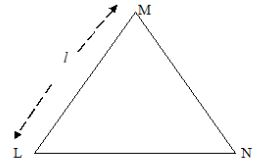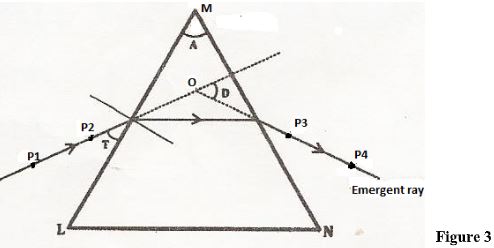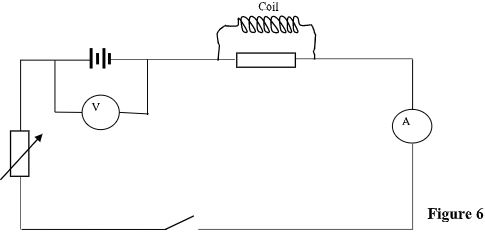INSTRUCTIONS TO CANDIDATES
- This paper consists of two questions 1 and 2.
- Answer all questions in the spaces provided.
- Non-programmable calculators and mathematical tables may be used.
- Show all your workings.

Questions
QUESTION 1
PART A
You are provided with the following:
- A watch glass
- A piece of plasticine
- A marble
- A Stopwatch
- An electronic balance (to be shared)
- Vernier calipers (to be shared)
- Geometrical set
Proceed as follows:- Measure the mass, m of the marble.
m = …………………………g (1/2mark) - Place the watch glass on the table. Cut the plasticine into two pieces and use them to hold the watch glass firmly on the table as shown in Figure 1.
- Release the marble from one end of the watch glass and time 5 complete oscillation with the stopwatch. Repeat this one more time.
- Record your values in the Table 1 (11/2 marks)
Table 1
Attempt Time for 5 oscillations (seconds) Periodic time, T(s) 1st 2nd - Find the average periodic time T (1mark)
-
- Measure the diameter of the marble with the Vernier calipers, hence find its radius
Diameter, d = ………………… (1mark)
Radius, r = …………………….m (1/2mark) - Determine the volume of the marble given that V=4/3πr3 where π=3.142 (1mark)
- Calculate the radius of the curvature of the watch glass R from the formula R - r = 5gT²/7(2π)²
Where g=10m/s2 and π=3.142 (1mark)
- Measure the diameter of the marble with the Vernier calipers, hence find its radius
- Measure the mass, m of the marble.
PART B
You are provided with the following:
- A glass prism
- A plain sheet of paper
- A soft board
- 4 optical pins
- 2 Thumb tacks
Proceed as follows:
-
- Firmly fix the plain sheet of paper on the soft board using the thumb tacks and place the prism at the centre of the paper. Trace the outline of the prism using a pencil.
- Remove the prism from the outline and label the vertices of the outline L, M and N as shown in Figure 2
Measure Angle LMN and length, Ɩ using a ruler
Angle LMN = ……………………… (1mark)
Length, Ɩ = ………………………… (1mark) - On the side ML mark a point and draw the normal at that point. Measure an angle T, 60° from the line LM and draw a line along this angle as shown in Figure 3.
- Replace the prism on the outline and fix pins P1 and P2 on the 60° line at a distance of 3cm from each other. View the images of the pins P1 and P2 through side MN and fix P3 and P4 so that they appear to be on straight line with the images of P1 and P2.
- Remove the prism and the pins and draw a line to pass through the holes made by pins P3 and P4. Extend the line into the outline as shown in figure 3 above. Also extend the 60° line so that the two lines cross each other at point O. Determine angle D and record it in the Table 2
-
- Repeat the procedure and complete the Table 2 (2 1/2marks)
Table 2Angle T(°) 60° 50° 40° Angle D (°) Angle I°(90° - T) - Determine the average value Dm of D (1mark)
- Determine the constant k for the glass prism from the formula (2marks)
k = sin (A+Dm)
2
SinA/2 - State the significance of k (1mark)
- Repeat the procedure and complete the Table 2 (2 1/2marks)
PART C
You are provided with the following:
- A lens holder
- Convex lens
- A candle
- A white screen
- A metre rule
Proceed as follows:
- Set up the apparatus as shown in Figure 4
- Starting with u = 30 cm, adjust the position of the screen to obtain a sharp image of the candle flame. Record the value of v in Table 3.
-
- Repeat the procedure in (i) for u = 30 cm. Complete Table 3 (3marks)
Table 3
u(cm) v(cm) m = v/u 30 50 - Given that the focal length f of the lens satisfies the equation f = vm+1, determine the average value of the focal length, f. (2 marks)
- Repeat the procedure in (i) for u = 30 cm. Complete Table 3 (3marks)
QUESTION 2
You are provided with the following:
- An ammeter (0 – 1 A)
- A voltmeter (0 – 3 V or 0 – 5 V)
- A variable resistor
- A 10Ω carbon resistor
- A piece of resistance wire
- Two new dry cells
- A cell holder
- A switch
- Seven connecting wires
Proceed as follows:
- Take the resistant wire and coil it around the biro pen to make a coil.
- Set up the apparatus as shown Figure 5 below such that the 10Ω carbon resistor and the coil are in parallel connection.
- Close the switch and the adjust the variable resistor such that the ammeter read a current of I1=0.08A and record the corresponding voltmeter reading V1
- V1 =………………… (1mark)
- Calculate resistance R1= V₁/I₁(1mark)
- Repeat (c) above for current of I2 = 0.16A and record the corresponding voltmeter reading V2
- V2 =………………… (1mark)
- Calculate resistance R2= V₂/I₂ (1mark)
- Find the average value of resistance R (1mark)
- Determine the resistance, C of the coil (2marks)
- Now set up the apparatus as shown in Figure 6 below such that the voltmeter is connected across the cells, 10Ω carbon resistor and the coil are in parallel connection.
- Close the switch and the adjust the variable resistor such that the ammeter reads a current of 0.04A and note the corresponding voltmeter reading. Record the value in the Table 4 below.
- Repeat (h) above for other values of current and voltage and complete the Table 4 below
(4marks)
Table 4
Current, I(A) 0.04 0.08 0.12 0.16 0.20 0.24 Voltage, V(V) - On the grid provided plot a graph of Voltage, V (V) against Current, I (A) (5marks)
- Determine the slope of the of the graph (2marks)
- Given that graph is related to equation E=V+ Ir where E and r are the emf and internal resistance of the cells respectively, use your graph to determine the value of:
E =…………………… (1mark)
r =……….…………. (1mark)

Confidential
INSTRUCTIONS TO SCHOOLS:
- The information contained in this paper is to enable the head of school and the teacher in charge of Physics to make adequate preparation for this Physics practical examination. NO ONE ELSE should have access to this paper or acquire knowledge of its contents. Great care MUST be taken to ensure that the information herein does not reach the candidates either directly or indirectly.
- The apparatus required by each candidate for the Physics Practical examination are set out on below. It is expected that the ordinary apparatus of a Physics laboratory will be available.
- The Physics teacher should note that it is his/her responsibility to ensure that each apparatus acquired for this examination agrees with the specifications as indicated on the list of apparatus below.
- The question paper will not be opened in advance.
- The Physics teacher is not expected to perform the experiments.
NB: Any use of apparatus other than the ones specified may lead to candidates being penalized.
QUESTION ONE
Every student should be provided with the following:
- A lens holder
- Convex lens of (focal length 15.0 cm + 1cm)
- A candle
- A white screen
- A metre rule
- A Equilateral triangular glass prism of side 3.7cm
- A plain sheet of paper
- A soft board
- 4 optical pins /thumbs
- 4 paper pins
- A watch glass of (diameter 10.0cm + 1cm)
- A piece of plasticine about 20g
- A marble of (diameter 1.60 cm+ 0.50cm)
- A Stopwatch-An electronic balance (to be shared)
- Vernier calipers (to be shared)
- Geometrical set
QUESTION TWO
- An ammeter (0 – 1 A)
- A voltmeter (0 – 3 V or 0 – 5 V)
- A variable resistor of 100Ω
- A 10Ω carbon resistor
- A piece of resistance wire (SWG 30) 50cm long
- Two New Size D dry cells
- A cell holder
- A switch
- Seven connecting wires of 4 should have crocodile clips both ends and 3 with crocodile clip on one end

Marking Scheme
QUESTION 1
PART A
- Measure the mass, m of the marble.
m = 4.8 + 0.5 g (1/2mark) - Place the watch glass on the table. Cut the plasticine into two pieces and use them to hold the watch glass firmly on the table as shown in Figure 1.
- Release the marble from one end of the watch glass and time 5 complete oscillation with the stopwatch. Repeat this one more time.
- Record your values in the Table 1 (11/2 marks)
Attempt Time for 5 oscillations (seconds) Periodic time, T(s) 1st 4.05 0.8100 2nd 4.02 0.8040 Range (3.50 - 4.50) dp a must @ 1/2mk Correct evaluation to 3sf all 1/2mk - Find the average periodic time T (1mark)
- principle of averaging must be shown ½ mk
- Correct evaluation to at least 4 s.f or Exact ½mk
- ignore units
-
- Measure the diameter of the marble with the Vernier calipers, hence find its radius
- Diameter, d = 1.60cm + 0.50 1d.p (1mark)
If missing units deny ½mk
Radius, r = 0.00825m (1/2mark)
- Diameter, d = 1.60cm + 0.50 1d.p (1mark)
- Determine the volume of the marble given that V=43πr3 where π=3.142 (1mark)
- Correct substitution 1/2mk
- Correct evaluation to 4 s.f or Exact ½mk
- ignore units
- Calculate the radius of the curvature of the watch glass R from the formula R-r =5gT27(2π)2
Where g=10m/s2 and π=3.142 (1mark)- Correct substitution 1/2mk
- Correct evaluation to 4 s.f or Exact ½mk
- Ignore units
- Measure the diameter of the marble with the Vernier calipers, hence find its radius
-
- Firmly fix the plain sheet of paper on the soft board using the thumb tacks and place the prism near the centre of the paper. Trace the outline of the prism using a pencil.
- Remove the prism from the outline and label the vertices of the outline L, M and N as shown in Figure 2
Measure Angle LMN and length, Ɩ using a ruler
Angle LMN = 600 + 10 Whole number (1mark)
Length, Ɩ = 3.8cm + 0.2cm 1.dp (1mark)
If missing units deny ½mk
If wrong units Penalize ½mk - On the side ML mark a point and draw the normal at that point. Measure an angle T, 60° from the line LM and draw a line along this angle as shown in Figure 3.
- Replace the prism on the outline and fix pins P1 and P2 on the 60° line at a distance of 3cm from each other. View the images of the pins P1 and P2 through side MN and fix P3 and P4 so that they appear to be on straight line with the images of P1 and P2.
- Remove the prism and the pins and draw a line to pass through the holes made by pins P3 and P4. Extend the line into the outline as shown in figure 3 above. Also extend the 60° line so that the two lines cross each other at point O. Determine angle D and record it in the Table 2
-
- Repeat the procedure and complete the Table 2 (2 1/2marks)
Table 2
Angle T(°) 60° 50° 40° Angle D (°) 47° 40° 39° Whole number ± Angle I°(90° - T) 13° 10° 1° Exact subtraction - Determine the average value Dm of D (1mark)
- Principle of averaging must be shown 1/2 mk
- Correct evaluation to 4 s.f or Exact 1/2 mk
- Ignore units
- Determine the constant k for the glass prism from the formula (2marks)
- Correct substitution 1mk
- Correct evaluation to 4 s.f or Exact 1mk
(k=1.5)
- State the significance of k (1mark)
- Refractive index of glass prism 1mk
- Repeat the procedure and complete the Table 2 (2 1/2marks)
- Starting with u = 30 cm, adjust the position of the screen to obtain a sharp image of the candle flame. Record the value of v in Table 3.
-
- Repeat the procedure in (g) for u = 30 cm. Complete Table 3 (3marks)
Table 3
u(cm) v(cm) m = v/u 30 30.0 1 50 21.5 0.43 1d.p ± 2.0 @ 1 mk Correct evaluation to 4 s.f or exact - Given that the focal length f of the lens satisfies the equation f=vm+1, determine the average value of the focal length, f. (2 marks)
- Principle of averaging must be shown 1mk
- Correct evaluation to 4 s.f or Exact 1mk
- Ignore units
- Repeat the procedure in (g) for u = 30 cm. Complete Table 3 (3marks)
QUESTION 2
- Take the resistant wire and coil it around the biro pen to make a coil.
- Set up the apparatus as shown below such that the 10Ω carbon resistor and the coil are in parallel connection.
- Close the switch and the adjust the variable resistor such that the ammeter read a current of 0.08A and record the corresponding voltmeter reading V1
- V1 = 0.35 V + 0.10V at least 1d.p (1mark)
- Calculate total external resistance (1mark)
- Correct substitution ½ mk
- Correct evaluation to 4 s.f or exact ½ mk
- If missing unit deny ½mk
- If wrong units Penalize ½mk
- Repeat (c) above for current of 0.16A and record the corresponding voltmeter reading V2
- V2 = 0.70 V+ 0.10V at least 1d.p (1mark)
- Calculate total external resistance (1mark)
- Correct substitution ½ mk
- Correct evaluation to 4s.f or exact ½ mk
- If missing unit deny ½mk
- If wrong units Penalize ½mk
- Find the average value of total external resistance R (1mark)
- Principle of averaging shown ½ mk
- Correct evaluation to 4s.f or exact ½ mk
- If missing unit deny ½mk
- If wrong units Penalize ½mk
- Determine the resistance, C of the coil (2marks)
- Application of the formula or 1mk
- Correct evaluation of C to 4s.f or exact 1mk
- If missing unit deny 1mk
- If wrong units Penalize 1mk
- Now set up the apparatus as shown below such that the voltmeter is connected across the cells, 10Ω carbon resistor and the coil are in parallel connection.
- Close the switch and the adjust the variable resistor such that the ammeter read a current of 0.04A and note the corresponding voltmeter reading. Record the value in the table below.
- Repeat (g) above for other values of current and voltage and complete the table below
Current, I(A) 0.04 0.08 0.12 0.16 0.20 0.24 Voltage, V(V) 2.9 2.8 2.7 2.6 2.5 2.4
Each 1mk to a max of 4 correct values + 0.3V at least 1d.p
NB: Voltage, V should NOT go beyond 3.0V (4marks) - On the grid provided plot a graph of Voltage, V (V) against Current, I (A) (5marks)
- Determine the slope of the of the graph (2marks)
- Change in y ½mk
- Change in x ½mk
- Correct evaluation to 4s.f or exact 1mk
- If missing unit deny ½mk
- If wrong units Penalize ½mk
- Given that graph is related to equation where E and r are the emf and internal resistance of the cells respectively. Use your graph to determine the value of:
- E = y – intercept. (1mark)
- To be read from the graph, so graph should be extrapolated.
- If missing unit deny ½ mk
- Penalise fully if graph not extrapolated
- r = Slope (1mark)
- Ignore sign
- If missing unit deny ½ mk
Download Physics Paper 3 Questions and Answers with Confidentials - Bunamfan Cluster Pre Mock Exam 2022.
Tap Here to Download for 50/-
Get on WhatsApp for 50/-
Why download?
- ✔ To read offline at any time.
- ✔ To Print at your convenience
- ✔ Share Easily with Friends / Students






